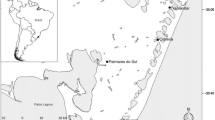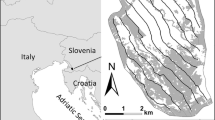Abstract
Human-induced disturbances induce heterogeneity at patch and landscape scale, affecting plants and animals differently. In this study, we analyzed the diversity of three oak forest patches (one of them recently coppiced) in Mediterranean Central Italy. Vascular plants were censused on a raster of squares of 10,000 m2. Breeding birds were censused with the point-sampling method. In the three wood patches studied, we observed a clear pattern in diversity with similarities and differences between plants and birds. A mature wood patch (Foglino North) showed the highest total number of species (a measure of γ-diversity at wood patch scale) both for birds and plants but, at level of mean species richness (an averaged measure of α-diversity at sampling point scale), birds showed values significantly different among wood patches with the lowest value in the recently coppiced wood patch (Armellino); on the contrary, the plants did not show differences among patches. In the coppiced wood patch, birds showed the highest value of species turnover among sampling points (a measure of β-diversity at wood patch scale), while plants showed the lowest value. Data suggest that when comparing a coppiced wood patch to a mature wood patch, human-induced heterogeneity developed by coppice management may affect diversity in vascular plants and breeding birds differently at different hierarchical level (i.e., α-, β-, γ-level). This human-induced heterogeneity may decrease the α-diversity values in birds, while it may favor an increase in plants. Moreover, with coppice management, species turnover among sites (a measure of β-diversity) may decrease in plants while may increase in birds. We hypothesize that this different pattern may be due to intrinsic characterization of these two taxa (different number of species, sessile vs. vagile strategies of dispersion, different scales of the assemblages) and to different methods of sampling them.
Similar content being viewed by others
References
Anzalone B, Iberite M, Lattanzi E (2010) La Flora vascolare del Lazio. Informatore Botanico Italiano 42:187–317
Bacaro G, Rocchini D, Bonini I, Marignani M, Maccherini S, Chiarucci A (2008) The role of regional and local scale predictors for plant species richness in Mediterranean forests. Plant Biosyst 142:630–642
Bibby CJ, Burgess ND, Hill DA, Mustoe S (2000) Bird census techniques, 2nd edn. Academic Press, London
Caneva G, Travaglini CM (2003). Atlante storico-ambientale Anzio-Nettuno. De Luca editore, Rome, CROMA-Province of Rome
Contoli L (2004) Gamma-diversità in Italia: una…gamma imprevedibile? II Grifone 13:1–2
Debussche M, Debussche G, Lepart J (2001) Changes in the vegetation of Quercus pubescens woodland after cessation of coppicing and grazing. J Veg Sci 12:81–92
Frank B, Battisti C (2005) Area effect on bird communities, guilds and species in a highly fragmented forest landscape of Central Italy. Ital J Zool 72:297–304
Hobbs RJ, Huenneke LF (1992) Disturbance, diversity and invasions: implications for conservations. Conserv Biol 6:324–337
Krebs CJ (2001) Ecology, 5th edn. Benjamin Cummings, San Francisco
Kumar S, Stohlgren TJ, Chong GW (2006) Spatial heterogeneity influences native and nonnative plant species richness. Ecology 87:3186–3199
Lattanzi E, Perinelli E, Riggio L (2004) Flora vascolare del bosco di Foglino (Nettuno–Roma). Informatore Botanico Italiano 36:337–361
Lorenzetti E, Battisti C (2006) Area as component of habitat fragmentation: corroborating its role in breeding bird communities and guilds of oak wood fragments in Central Italy. Revue d’Ecologie (Terre Vie) 61:53–68
Magurran A (2004) Measuring biological diversity. Blackwell, Malden
Malavasi R, Battisti C, Carpaneto GM (2009) Seasonal bird assemblages in a Mediterranean patchy wetland: corroborating the intermediate disturbance hypothesis. Polish J Ecol 57:171–179
Pickett STA, White PS (eds) (1985) The ecology of natural disturbance and patch dynamics. Academic Press, Orlando
Roth RR (1976) Spatial heterogeneity and bird species diversity. Ecology 57:773–782
Sutherland WJ (2006) Ecological census techniques. Blackwell, London
Tews J, Brose U, Grimm V, Tielbörger K, Wichmann MC, Schwager M, Jeltsch F (2004) Animal species diversity driven by habitat heterogeneity/diversity: the importance of keystone structures. J Biogeogr 31:79–92
Ukmar E, Battisti C, Luiselli L, Bologna MA (2006) The effect of fire on communities, guilds and species in burnt and control pinewoods in central Italy. Biodiv Conserv 16:3287–3300
Whittaker RH (1960) Vegetation of the Siskiyou Mountains, Oregon and California. Ecol Monogr 30:279–338
Whittaker RH (1972) Evolution and measurement of species diversity. Taxon 21:213–251
Wiens JA (1976) Population responses to patchy environments. Annu Rev Ecol Syst 7:81–120
Wiens JA (1989) The ecology of bird communities. In: Processes and variations. Cambridge studies in ecology, vol 2. Cambridge University Press, Cambridge
Acknowledgments
We wish to thank Longino Contoli and two anonymous referees for useful comments, and Mafalda Cerrito for help in plant sampling.
Author information
Authors and Affiliations
Corresponding author
Rights and permissions
About this article
Cite this article
Battisti, C., Fanelli, G. Does human-induced heterogeneity differently affect diversity in vascular plants and breeding birds? Evidences from three Mediterranean forest patches. Rend. Fis. Acc. Lincei 22, 25–30 (2011). https://doi.org/10.1007/s12210-010-0111-3
Received:
Accepted:
Published:
Issue Date:
DOI: https://doi.org/10.1007/s12210-010-0111-3




